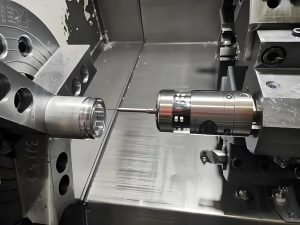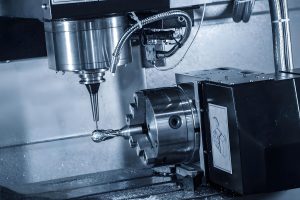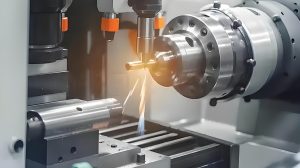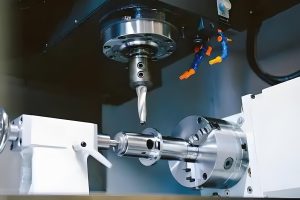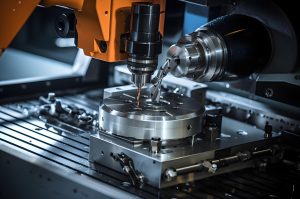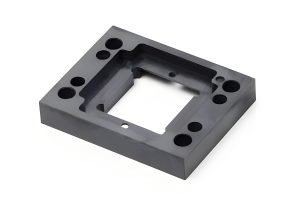Introduction
In the modern manufacturing industry, CNC lathe machining plays a crucial role. It has become an essential part of producing high – precision parts across various sectors, from aerospace to automotive, and from electronics to medical devices. With the continuous development of technology, the demand for efficient and accurate CNC lathe machining is on the rise.
Rapidefficient CNC Lathe Machining, a remarkable solution in this field, has attracted widespread attention. It combines advanced technology with high – speed processing capabilities, aiming to meet the diverse needs of modern manufacturing. In the following content, we will explore in – depth the world of CNC lathe machining, and discover how Rapidefficient stands out in this highly competitive market. Whether you are a professional in the manufacturing industry or simply interested in the latest manufacturing technologies, this article will provide you with valuable insights.
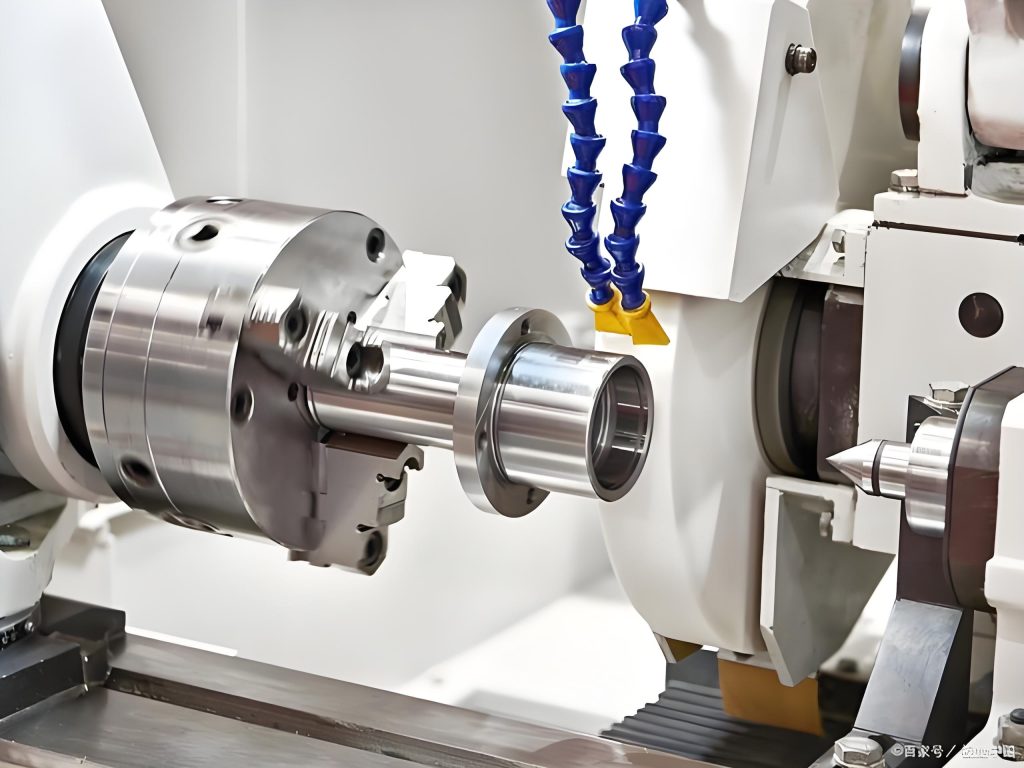
What is CNC Lathe Machining
CNC lathe machining, short for Computer Numerical Control lathe machining, is a highly automated manufacturing process. It uses pre – programmed computer software to control the movement of a lathe, which is a machine tool that rotates the workpiece on its axis while various cutting tools are applied to remove material and shape the workpiece into the desired form.
Working Principle
The basic principle of CNC lathe machining is based on the relative movement between the cutting tool and the rotating workpiece. When the process begins, a solid workpiece, usually made of materials like metal (such as aluminum, steel, brass), plastic, or even wood, is firmly clamped onto the spindle of the lathe. The spindle rotates the workpiece at a high speed. Meanwhile, the cutting tool, which is held by a tool holder, is moved along different axes (usually the X, Z, and sometimes Y axes in more advanced lathes) according to the pre – programmed instructions.
These instructions are generated from a CAD (Computer – Aided Design) model of the part to be produced. The CAD model precisely defines the dimensions and shape of the final product. Through CAM (Computer – Aided Manufacturing) software, the design is translated into a series of numerical codes, known as G – code and M – code. G – code controls the movement of the axes, such as linear and circular interpolation, which determine how the cutting tool moves around the workpiece. M – code, on the other hand, is used to control other functions of the lathe, like spindle speed, coolant flow, and tool changes.
Key Technologies
- Precision Motion Control: This is a crucial technology in CNC lathe machining. High – precision servo motors are used to drive the axes of the lathe. These motors can accurately control the position and speed of the cutting tool. For example, modern CNC lathes can achieve positioning accuracy up to ±0.001mm, which ensures that the parts produced have extremely tight tolerances. This high – precision motion control is essential for manufacturing parts that require a high level of accuracy, such as aerospace components or medical implants.
- Tooling Systems: The choice of cutting tools and the tooling system is also of great importance. Different materials and machining requirements call for different types of cutting tools. For instance, carbide – tipped tools are often used for machining hard metals because of their high hardness and wear resistance. Additionally, tool – changing systems, such as automatic tool changers (ATCs), are used in many CNC lathes. ATCs can quickly and accurately change the cutting tools during the machining process, which significantly improves the efficiency of the machining operation. This allows for the completion of multiple machining operations, such as turning, threading, drilling, and boring, on the same workpiece without the need for manual tool changes.
- CNC Control Systems: The CNC control system is the “brain” of the lathe. It interprets the G – code and M – code instructions and sends signals to the servo motors and other components of the lathe to execute the machining operations. Advanced CNC control systems are equipped with features like real – time monitoring and error – compensation. They can monitor the machining process in real – time, detect any potential problems such as tool wear or collisions, and make adjustments to ensure the smooth progress of the machining. Error – compensation algorithms can correct for any errors caused by factors like thermal expansion, mechanical wear, and backlash in the machine’s components, further enhancing the accuracy of the machining.
The Advantages of CNC Lathe Machining
Precision and Accuracy
One of the most prominent advantages of CNC lathe machining is its exceptional precision and accuracy. In traditional lathe machining, human operation plays a significant role, and even the most skilled operators may introduce small errors due to factors such as fatigue, inattention, or inconsistent hand – eye coordination. However, CNC lathe machining eliminates many of these human – related errors.
Thanks to the highly precise motion control system and the pre – programmed instructions, CNC lathes can achieve extremely tight tolerances. For example, in the manufacturing of aerospace components, parts such as turbine blades and engine shafts require extremely high precision. The tolerance requirements for these parts can be as tight as ±0.001mm. CNC lathe machining can easily meet these strict requirements, ensuring that each part produced is almost identical to the design specifications. This high level of precision and accuracy not only improves the quality of the final product but also reduces the need for rework and waste, which is crucial in industries where cost – effectiveness and product reliability are of utmost importance.
High Efficiency
CNC lathe machining offers remarkable efficiency compared to traditional machining methods. Firstly, the automation feature of CNC lathes is a major contributor to their high – speed operation. Once the program is set up and the workpiece is loaded, the CNC lathe can run continuously without the need for constant human intervention. This allows for long – term, unattended operation, which is especially beneficial for large – scale production runs.
In contrast, traditional lathe machining often requires an operator to manually control the movement of the cutting tool, adjust the spindle speed, and change the cutting tools. These manual operations are time – consuming and limit the speed at which the machining process can be carried out. For instance, in a mass – production scenario of automotive parts, a CNC lathe can produce hundreds of parts in an hour, while a traditional lathe would take much longer to achieve the same output.
Moreover, the use of advanced tool – changing systems, such as automatic tool changers (ATCs), further enhances the efficiency of CNC lathe machining. ATCs can quickly switch between different cutting tools, enabling multiple machining operations to be completed on the same workpiece in one continuous process. This reduces the overall machining time and increases the productivity of the manufacturing process.
Versatility
CNC lathe machining is highly versatile, capable of handling a wide range of materials and producing complex – shaped parts. In terms of materials, CNC lathes can work with various metals, including aluminum, steel, brass, titanium, and copper. Each of these metals has different properties, such as hardness, ductility, and thermal conductivity, but CNC lathes can be adjusted to accommodate these differences through appropriate programming and tool selection.
For example, when machining aluminum, which is a relatively soft metal, high – speed cutting tools can be used to achieve fast material removal rates. On the other hand, when working with hardened steel, carbide – tipped tools and slower cutting speeds are often required to ensure the quality of the cut. In addition to metals, CNC lathes can also process non – metallic materials like plastics, ceramics, and even wood, expanding their application scope to industries such as electronics, medical devices, and furniture manufacturing.
Regarding the complexity of the parts, CNC lathes can produce components with intricate shapes that would be extremely difficult or even impossible to manufacture using traditional methods. Through multi – axis control (such as 3 – axis, 4 – axis, or even 5 – axis in more advanced lathes), CNC lathes can perform operations like contour turning, threading, drilling at various angles, and milling complex surfaces. This makes them ideal for creating parts with complex geometries, such as impellers for pumps and turbines, which have curved blades and precise flow – passage designs.
Rapidefficient in CNC Machining Market
Unparalleled Speed
In the highly competitive CNC machining market, speed is of the essence. Rapidefficient CNC Lathe Machining stands out with its unparalleled speed. When compared to many of its competitors, Rapidefficient can complete machining tasks in a significantly shorter time.
For example, in the production of small – batch precision parts for the electronics industry, a typical competitor might take 30 minutes to complete a single part. However, Rapidefficient can achieve the same task in just 15 minutes. This is mainly due to its advanced high – speed spindle technology. The spindles in Rapidefficient CNC lathes can rotate at extremely high speeds, reaching up to 20,000 RPM in some models, while many competitors’ spindles top out at 12,000 – 15,000 RPM. This higher rotational speed allows for faster material removal rates, reducing the overall machining time for each part.
Exceptional Efficiency
Efficiency is another area where Rapidefficient shines. Its efficient workflow is designed to minimize production time and cost. Rapidefficient has implemented a one – click operation system in its CNC lathes. Once the operator inputs the machining parameters and initiates the process, the machine can automatically complete a series of complex operations, including tool changes, axis movements, and cutting operations, without the need for frequent manual intervention.
Moreover, Rapidefficient’s intelligent programming system can optimize the machining path based on the part’s geometry and material properties. This optimization reduces unnecessary tool movements and cutting times. For instance, in the manufacturing of a complex – shaped automotive component, the intelligent programming system of Rapidefficient can shorten the machining time by 30% compared to traditional programming methods. In terms of cost – effectiveness, the high – efficiency operation of Rapidefficient CNC lathes means lower labor costs per unit and reduced energy consumption, making it a more cost – effective choice for manufacturers.
Quality Assurance
Rapidefficient places great importance on quality assurance and ensures that all its machining processes meet strict industry standards. First, it uses high – precision sensors and real – time monitoring systems during the machining process. These sensors can detect any deviations in the machining parameters, such as spindle speed, cutting force, and tool wear, in real – time. If any abnormalities are detected, the system can automatically adjust the machining parameters or stop the machine to prevent defects in the final product.
Second, Rapidefficient has a comprehensive quality control system in place. Each part produced undergoes a series of strict inspections, including dimensional accuracy checks using high – precision measuring instruments like coordinate measuring machines (CMMs), surface finish inspections, and material property tests. This multi – step inspection process ensures that only parts that meet the highest quality standards are released from the production line. For example, in the aerospace industry, where the quality requirements for parts are extremely high, Rapidefficient’s CNC lathe – machined parts have a defect rate of less than 0.1%, far lower than the industry average. This high – quality performance has earned Rapidefficient a good reputation in the market and made it a trusted choice for many high – end manufacturing enterprises.
Applications of Rapidefficient CNC Lathe Machining
Automotive Industry
In the automotive industry, the demand for high – quality, precisely – made parts is extremely high. Rapidefficient CNC Lathe Machining has found wide applications here. For example, in the production of engine components such as crankshafts and camshafts. These parts are crucial for the proper functioning of an engine. The crankshaft, which converts the reciprocating motion of the pistons into rotational motion, requires high precision in its machining. Rapidefficient’s high – speed and accurate CNC lathes can produce crankshafts with tight tolerances, ensuring smooth engine operation and reducing vibrations.
Another example is the manufacturing of transmission gears. Transmission gears need to have precise tooth profiles to ensure efficient power transfer and smooth gear – shifting. Rapidefficient CNC lathe machining can accurately cut the complex tooth shapes of gears, and its high – speed machining capabilities enable mass production, meeting the large – scale demand of the automotive industry. This not only improves the quality of automotive parts but also shortens the production cycle, reducing the overall production cost for automotive manufacturers.
Aerospace Industry
The aerospace industry has some of the most stringent requirements for part quality and precision. Rapidefficient CNC Lathe Machining has proven to be an invaluable asset in this field. For instance, in the production of aircraft engine components like turbine blades. Turbine blades operate in extremely harsh environments, with high temperatures, high pressures, and high rotational speeds. Therefore, they need to be made with the highest precision and from high – strength materials.
Rapidefficient’s advanced CNC lathes can machine turbine blades from materials such as titanium alloys with great accuracy. The high – speed spindles can quickly remove material while maintaining tight tolerances, which is crucial for the aerodynamic performance of the blades. In addition, for aircraft structural components like wing spars and fuselage frames, Rapidefficient’s CNC lathe – machined parts can ensure consistent quality and dimensional accuracy. This helps to improve the overall safety and performance of the aircraft, as any small defect in these components could have catastrophic consequences.
Electronics Industry
In the electronics industry, where miniaturization and high – precision are key trends, Rapidefficient CNC Lathe Machining also plays an important role. For example, in the production of electronic device housings. These housings need to be precisely machined to fit the internal components perfectly, while also being lightweight and aesthetically pleasing.
Rapidefficient’s CNC lathes can work with materials such as aluminum alloy to create thin – walled, highly precise housings. The high – speed machining allows for quick production, which is important in the fast – paced electronics market where new products are constantly being launched. Moreover, for components like heat sinks, which are crucial for dissipating heat from electronic devices, Rapidefficient’s CNC lathe – machining technology can create complex fin structures with high precision. These fins can effectively increase the surface area for heat dissipation, ensuring the stable operation of electronic devices.
Medical Device Industry
The medical device industry requires parts with the highest level of precision and quality, as the safety and effectiveness of medical devices depend on them. Rapidefficient CNC Lathe Machining has made significant contributions here. For example, in the manufacturing of surgical instruments. Surgical instruments need to be extremely sharp, durable, and have precise shapes for accurate surgical operations.
Rapidefficient’s CNC lathes can machine surgical instruments from high – quality stainless steel or titanium materials with great precision. The high – speed and efficient machining process can ensure a high – volume production of these instruments while maintaining strict quality control. In addition, for implantable medical devices such as hip implants and dental implants, Rapidefficient’s CNC lathe – machined parts can meet the strict biocompatibility and dimensional accuracy requirements. The smooth surface finish and precise dimensions of these implants are crucial for their long – term stability and functionality in the human body.
How to Choose a Reliable CNC Lathe Machining Service Provider
Experience and Expertise
When choosing a CNC lathe machining service provider, experience and expertise are of utmost importance. An experienced provider has a wealth of knowledge and skills accumulated over the years. They have dealt with various types of projects, materials, and machining challenges. For example, a company that has been in the CNC lathe machining business for over 10 years is likely to have encountered different material – specific machining issues. They would know how to handle the machining of heat – treated steel, which is more difficult to cut compared to regular steel, or how to work with brittle materials like ceramics without causing excessive breakage.
Expertise also extends to the understanding of different industries’ requirements. A service provider with expertise in the aerospace industry will be well – aware of the strict quality and precision standards that aerospace parts demand. They will have the necessary skills to produce parts with extremely tight tolerances and will be familiar with the specific materials and surface finish requirements of aerospace components. This in – depth knowledge ensures that the parts produced meet the high – quality standards of the industry and reduces the risk of defects and rework.
Equipment and Technology
Advanced equipment and technology are essential for high – quality CNC lathe machining. Modern CNC lathes are equipped with features that significantly improve the machining process. For instance, high – speed spindles can rotate at speeds of up to 30,000 RPM or even higher in some top – of – the – line models. This high – speed rotation allows for faster material removal, which not only shortens the machining time but also improves the surface finish of the parts.
In addition, multi – axis control technology is becoming increasingly important. 5 – axis CNC lathes, for example, can perform more complex machining operations compared to traditional 3 – axis lathes. They can machine parts from multiple angles without the need to re – position the workpiece, which is crucial for creating complex – shaped parts. Moreover, advanced CNC control systems with features like real – time monitoring and self – diagnosis can detect and correct potential problems during the machining process, ensuring the stability and accuracy of the machining. A service provider with state – of – the – art equipment and technology is more likely to deliver high – quality parts in a timely manner.
Customer Reviews and Reputation
Customer reviews and reputation are valuable references when choosing a CNC lathe machining service provider. Reading customer reviews can give you insights into the quality of the service, the reliability of the delivery time, and the overall customer satisfaction. For example, if a service provider has numerous positive reviews stating that they always meet the delivery deadlines, produce high – quality parts, and provide excellent after – sales service, it is a strong indication of their reliability.
On the other hand, negative reviews can highlight potential issues. If multiple customers complain about the inaccuracy of the parts or poor communication from the service provider, it is a red flag. A good reputation in the industry also means that the service provider is likely to have long – term relationships with its customers, which is a testament to their consistent quality and service. You can also check industry – specific review platforms, business directories, and ask for referrals from other manufacturers to get a more comprehensive understanding of the service provider’s reputation.
If you are looking for a reliable Rapidefficient CNC aluminum machining service provider, look no further than [Company Name]. They have a proven track record of delivering high – quality aluminum – machined parts with speed and efficiency. Their team of experienced professionals, combined with advanced equipment and technology, ensures that every project is completed to the highest standards. Whether you need small – batch or large – scale production, [Company Name] can meet your CNC aluminum machining needs. Contact them today to learn more about how they can help you with your next project.
Recommendation for Rapidefficient CNC Aluminum Processing Service Providers
If you are looking for a reliable Rapidefficient CNC aluminum machining service provider, look no further than [Company Name]. They have a proven track record of delivering high – quality aluminum – machined parts with speed and efficiency. Their team of experienced professionals, combined with advanced equipment and technology, ensures that every project is completed to the highest standards. Whether you need small – batch or large – scale production, [Company Name] can meet your CNC aluminum machining needs. Contact them today to learn more about how they can help you with your next project.
Another excellent option is [Another Company Name]. This company specializes in Rapidefficient CNC aluminum processing and has built a reputation for its top – notch service. They use state – of – the – art CNC lathes with high – speed spindles that can handle aluminum materials with great precision. Their in – house quality control team conducts rigorous inspections at every stage of the production process, from raw material inspection to the final product. This ensures that the aluminum parts produced are not only dimensionally accurate but also have excellent surface finishes. Additionally, [Another Company Name] offers comprehensive customer support, providing quick responses to inquiries and after – sales service, which makes them a reliable partner for all your CNC aluminum machining requirements.
Conclusion
In conclusion, CNC lathe machining is an indispensable part of modern manufacturing. Its precision, efficiency, and versatility have made it a go – to solution for producing high – quality parts across multiple industries. From the automotive industry to aerospace, electronics, and medical devices, CNC lathe – machined parts are the building blocks that ensure the smooth operation and high – performance of various products.
Rapidefficient CNC Lathe Machining, with its unique features of high speed, exceptional efficiency, and strict quality assurance, has carved out a special place in the CNC machining market. It offers manufacturers a competitive edge by reducing production time, lowering costs, and delivering top – notch quality parts.
When it comes to choosing a CNC lathe machining service provider, it is crucial to consider factors such as experience, equipment, and reputation. By making an informed choice, businesses can ensure that they receive the best – quality machining services that meet their specific requirements.
If you are in need of CNC aluminum machining services, don’t hesitate to explore the options provided by the recommended service providers like [Company Name] and [Another Company Name]. Their expertise in Rapidefficient CNC aluminum processing, combined with their commitment to quality and customer satisfaction, makes them reliable partners for all your machining needs. Take the first step towards high – quality, efficient CNC machining by reaching out to them today.

